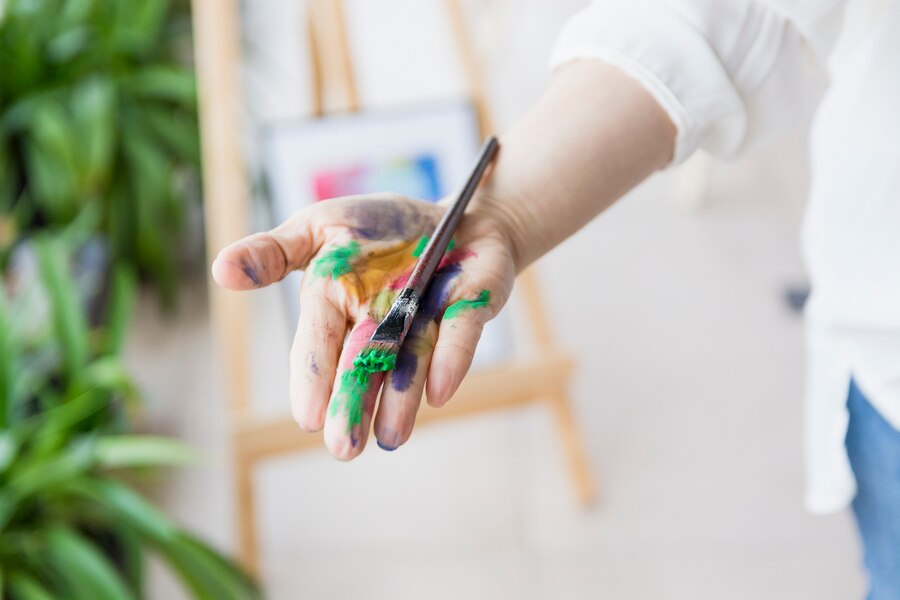
Introduction
Oil painting has been a beloved medium for artists across centuries, from the Renaissance masters to contemporary creators. However, traditional oil paints often contain toxic solvents and heavy metals that can pose health risks, especially when used indoors. This has led to a growing demand for non-toxic alternatives that maintain the rich qualities of oil paint while ensuring safety for artists, their families, and the environment. As more people explore artistic pursuits at home, particularly in smaller urban living spaces, the importance of non-toxic oil paints becomes increasingly significant. This comprehensive guide explores the world of non-toxic oil paints suitable for indoor use, their benefits, top brands, application techniques, and safety considerations to help both beginners and experienced artists make informed choices about their painting materials.
Understanding Non-Toxic Oil Paints
Non-toxic oil paints are formulated to eliminate or significantly reduce harmful chemicals traditionally found in oil painting materials. According to the Art & Creative Materials Institute (ACMI), truly non-toxic art materials must meet specific safety standards and carry their AP (Approved Product) seal. Traditional oil paints often contain heavy metals like cadmium, cobalt, and lead as pigments, alongside volatile organic compounds (VOCs) in their solvents and mediums. In contrast, non-toxic oil paints use alternative pigments derived from safer sources and are typically paired with low-odor, plant-based solvents and mediums. The Environmental Protection Agency notes that reducing VOC exposure is particularly important in indoor environments where ventilation may be limited. Artists working with water-mixable oils or those formulated with safer ingredients can maintain studio practices that protect both their health and the quality of their indoor air while still enjoying the distinctive working properties that make oil painting so appealing.
Benefits of Non-Toxic Oil Paints for Indoor Use
The advantages of using non-toxic oil paints extend far beyond basic safety considerations. From a health perspective, these safer formulations reduce exposure to carcinogens, neurotoxins, and respiratory irritants that are particularly concerning in enclosed spaces. The American Lung Association emphasizes that indoor air pollution can be two to five times higher than outdoor levels, making paint choice critically important for studio artists. From a practical standpoint, non-toxic oil paints often have minimal odor, allowing for comfortable painting sessions without opening windows or using special ventilation systems—ideal for apartment dwellers or those painting in shared spaces. Many artists report that water-mixable oils and other safer formulations offer excellent workability, with the National Gallery’s Technical Bulletin confirming that modern non-toxic oils can achieve results comparable to traditional oils. Additionally, the eco-friendly nature of these paints reduces environmental impact, aligning with sustainable art practices advocated by organizations like the Artist’s Resource for Sustainability.
Types of Non-Toxic Oil Paints
Water-Mixable Oil Paints
Water-mixable (or water-soluble) oil paints represent one of the most significant innovations in making oil painting safer for indoor use. These paints contain modified oil molecules that allow them to be thinned and cleaned up with water instead of toxic solvents. According to Jackson’s Art Supplies, these paints maintain the consistency, texture, and appearance of traditional oils while eliminating the need for turpentine or mineral spirits. Leading brands include Holbein Duo Aqua Oils, Royal Talens Cobra, and Daniel Smith Water Soluble Oils. The Royal Academy of Arts notes that many professional artists have successfully transitioned to water-mixable oils, appreciating both the safer studio environment and the reduction in waste disposal concerns.
Oil Paints with Natural Pigments
Non-toxic oil paints often utilize natural earth pigments and organic colorants instead of heavy metal-based alternatives. The Natural Pigment Institute explains that earth colors like ochres, umbers, and siennas have been used safely for millennia, while modern organic pigments can now reliably replace many toxic colors. Brands like Natural Earth Paint and Williamsburg Handmade Oil Colors offer extensive ranges featuring naturally-derived pigments. These paints typically avoid cadmium, cobalt, lead, and other toxic metals that the Occupational Safety and Health Administration (OSHA) identifies as hazardous, particularly in poorly ventilated spaces. Artists interested in historical painting techniques may find these naturally-pigmented options particularly appealing, as they connect modern health consciousness with traditional craftsmanship.
Solvent-Free Oil Paints
Some innovative manufacturers have developed completely solvent-free oil paints designed specifically for indoor use. These formulations incorporate plant-based oils and waxes that eliminate the need for thinners entirely. According to Winsor & Newton, their Artisan Water Mixable Oil Colour range was developed to provide a genuine oil painting experience without solvents. Similarly, M. Graham produces oil paints using walnut oil, which naturally yellows less than linseed oil and reduces the need for additional solvents. The American Institute for Conservation reports that these solvent-free approaches not only benefit artists’ health but can also produce paintings with excellent longevity and resistance to yellowing.
Top Brands of Non-Toxic Oil Paints
Gamblin Conservation Colors
Developed in collaboration with conservators, Gamblin Conservation Colors represent the gold standard in non-toxic oil paints. These professional-grade colors are made with Laropal A-81, a urea aldehyde resin, instead of traditional linseed oil, eliminating many common concerns about toxicity while maintaining archival quality. The Getty Conservation Institute has recognized these paints for their combination of safety and performance. Though originally created for art restoration, many studio artists now use them for original works, particularly when working in limited ventilation situations.
Daniel Smith Water Soluble Oils
Daniel Smith has created water-soluble oils that offer the feel and finish of traditional oils without the hazardous solvents. Their extensive color range includes many unique pigments, and their formulation allows for water cleanup while still being compatible with traditional oil painting techniques. According to Artist Daily, Daniel Smith’s water-soluble oils are particularly noted for their creamy consistency and excellent tinting strength, making them popular among artists who need non-toxic options without compromising on quality.
M. Graham Walnut Oil Paints
M. Graham uses walnut oil instead of linseed oil as the binder for their oil paints, creating a naturally more fluid paint that requires less solvent for thinning. The American Art Therapy Association recommends walnut oil-based paints for therapeutic settings due to their minimal odor and reduced toxicity. These paints offer excellent lightfastness, and many artists report that the walnut oil creates a distinctive luminosity in finished works. The company’s commitment to environmentally responsible manufacturing has been highlighted by Sustainable Business Oregon.
Essential Safety Practices for Indoor Oil Painting
Proper Ventilation Strategies
Even when using non-toxic oil paints, proper ventilation remains important for indoor painting sessions. The Centers for Disease Control and Prevention (CDC) recommends maintaining good air circulation when working with any art materials. For those without access to specialized studio ventilation, portable air purifiers with HEPA and activated carbon filters can help remove airborne particles and odors. Opening windows periodically or using window fans to create cross-ventilation can significantly improve air quality, as recommended by Princeton University’s Environmental Health and Safety guidelines.
Safe Cleanup Methods
Non-toxic oil painting extends beyond the paints themselves to include cleanup procedures. Instead of mineral spirits or turpentine, artists can use safer alternatives like The Masters Brush Cleaner or baby oil for cleaning brushes. For water-mixable oils, warm water and mild soap are usually sufficient. The Art Safety Institute recommends avoiding skin contact with all paint products regardless of toxicity claims, suggesting the use of nitrile gloves during cleanup. Proper disposal of paint waste is also crucial—the EPA’s household hazardous waste guidelines provide information on responsibly discarding even non-toxic art materials.
Application Techniques for Non-Toxic Oil Painting
Working with Water-Mixable Oils
Water-mixable oils require slightly different techniques than traditional oils. According to tutorials from Artists Network, these paints benefit from being mixed with their specific mediums rather than just water to maintain proper adhesion and finish. The Royal Talens Institute suggests building thin layers with slightly diluted paint before working up to thicker impastos, which helps prevent cracking as the paint dries. Unlike traditional oils, water-mixable versions tend to dry slightly faster, which can be advantageous for indoor painters concerned about lingering odors from slow-drying works.
Achieving Traditional Effects with Non-Toxic Materials
Artists needn’t sacrifice traditional oil painting techniques when using non-toxic alternatives. The Art of Education University recommends experimenting with non-toxic glazing mediums to achieve the luminous effects traditionally created with solvent-heavy mixtures. For texture and impasto work, non-toxic modeling pastes and thickening gels can replace traditional lead-containing mediums. Many contemporary artists featured in American Artist magazine have demonstrated that techniques like alla prima, glazing, and scumbling can all be successfully executed with safer materials.
Frequently Asked Questions
Are non-toxic oil paints as durable as traditional oils?
Yes, high-quality non-toxic oil paints are formulated to meet or exceed the durability standards of traditional oils. According to conservation research from the Smithsonian American Art Museum, properly applied non-toxic oils can create paintings with excellent longevity. Water-mixable oils form the same durable film as conventional oils once dry, while natural pigment paints often demonstrate exceptional lightfastness. The key factors affecting durability remain proper application technique and the use of quality supports and grounds, rather than toxicity level of the paints themselves.
Can I mix non-toxic oil paints with traditional oil colors?
In most cases, yes, though with some considerations. The National Gallery of Art’s conservation department notes that water-mixable oils can be mixed with traditional oils, but this reduces their water-solubility proportionally. For best results, manufacturers like Winsor & Newton recommend using mediums specifically designed for your primary paint type. When mixing paint types, remember that the resulting mixture will take on properties of both paints, potentially affecting drying time and final appearance.
How can I tell if an oil paint is truly non-toxic?
Look for specific certifications and ingredient disclosures. The Art & Creative Materials Institute (ACMI) certification with an “AP” (Approved Product) seal indicates materials evaluated as non-toxic. Reputable manufacturers will typically provide Safety Data Sheets (SDS) listing all hazardous ingredients, as required by the U.S. Consumer Product Safety Commission. Avoid products that don’t disclose their full ingredient list or make vague “non-toxic” claims without certification. Remember that even non-toxic paints may contain ingredients that could cause individual allergic reactions in some users.
Do non-toxic oil paints work for all painting techniques?
Most contemporary oil painting techniques can be adapted for non-toxic materials. The Museum of Modern Art’s conservation department has documented successful use of water-mixable oils in a wide range of applications. That said, certain historical techniques requiring specific toxic materials (like lead white for particular impasto effects) may require adaptation. Professional artists featured in PleinAir Magazine regularly demonstrate that techniques from alla prima to complex glazing can be accomplished with safer materials, though sometimes with slight modifications to process.
Conclusion
The evolution of non-toxic oil paints represents a significant advancement for indoor artists, combining the rich tradition of oil painting with modern safety considerations. As this comprehensive exploration has shown, today’s non-toxic alternatives offer remarkable versatility, quality, and performance while substantially reducing health risks associated with traditional oil painting. From water-mixable formulations that eliminate solvent exposure to natural pigment options that avoid heavy metals, artists now have unprecedented choices for creating beautiful, archival-quality work in even the most limited indoor spaces.
The growing market for these safer alternatives reflects a broader shift in art materials—one that prioritizes both artistic expression and personal wellbeing. Organizations like the Art & Creative Materials Institute continue to develop more rigorous safety standards, while innovative manufacturers constantly improve non-toxic formulations to match or exceed the performance of their traditional counterparts. For contemporary artists, this means no longer having to choose between health and artistic vision.
As you explore non-toxic oil painting, remember that best practices still matter—proper ventilation, appropriate cleanup procedures, and responsible waste disposal all contribute to a truly safe studio environment. By combining high-quality non-toxic materials with thoughtful studio habits, you can enjoy the timeless medium of oil painting without compromise, creating work that honors both artistic tradition and modern health consciousness. Whether you’re a professional artist, an art educator, or a hobbyist painter, embracing non-toxic oil paints opens new possibilities for creative expression in any indoor environment.
